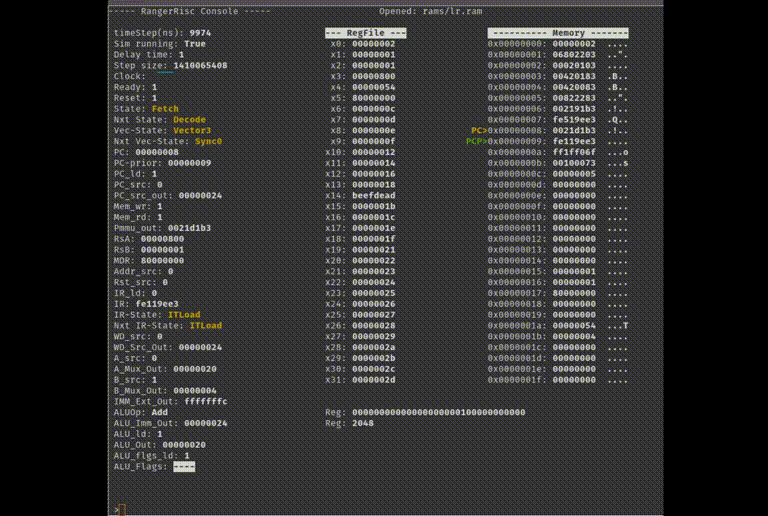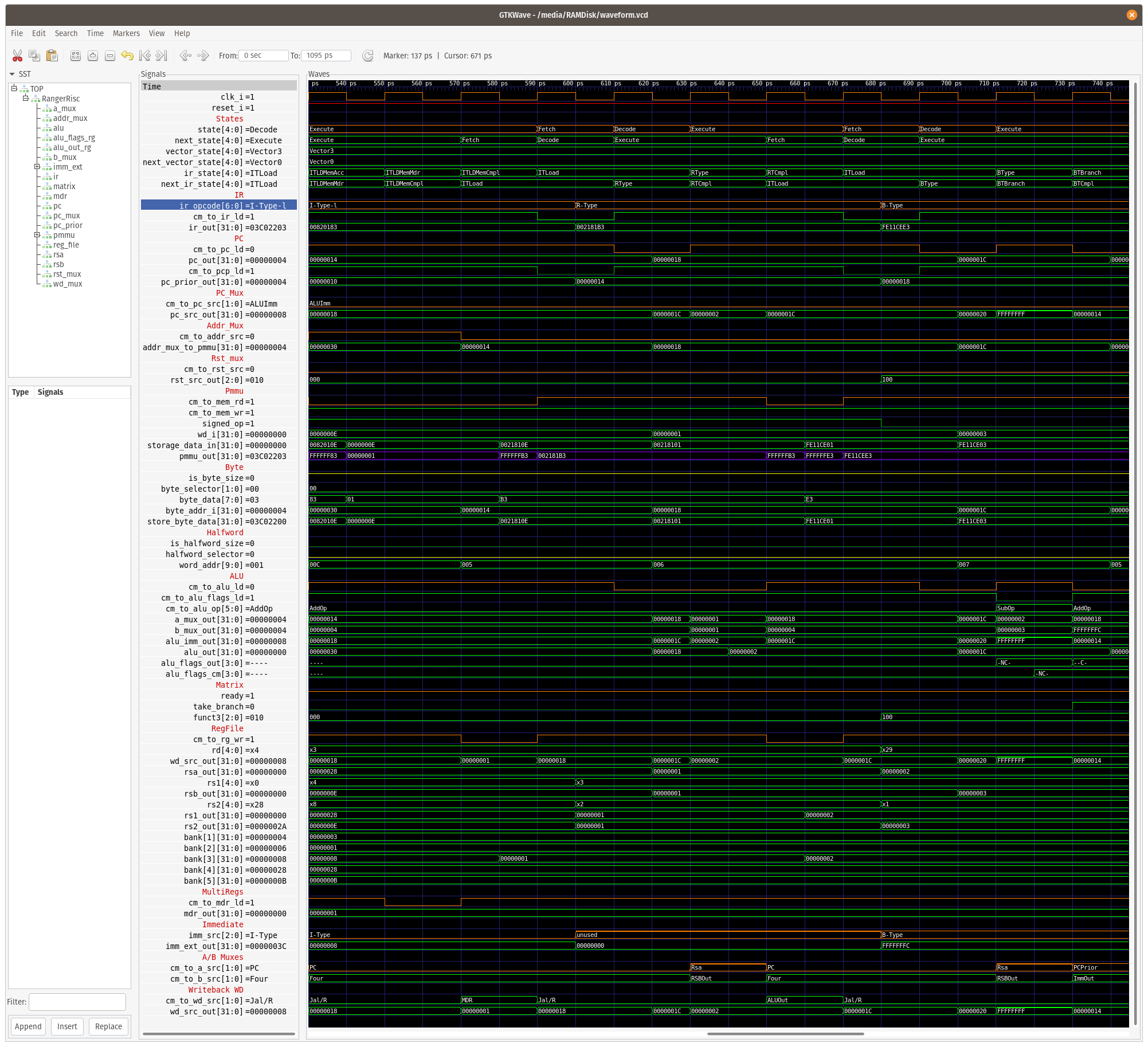Ranger Risc (RISC-V-RV32I-MultiCycle)
An intuitive multi-cycle RISC-V RV32I soft-core processor for FPGAs using open source software and Folknology's BlackIce Mx.
This repository represents the After Hours Engineering Youtube series.
Components
[x] Mux(s)
[x] Register
[x] RegisterFile
[x] ALU
[x] Immediate
[x] Memory
[x] Pmmu
[x] ControlMatrix
Simulation
[x] Mux(s)
[x] Register
[x] RegisterFile
[x] ALU
[x] Immediate
[x] Memory
[x] Pmmu
[x] Instruction Register
[x] RangerRisc
[x] Testbench GtkWave
[x] Testbench NCurses
Howto(s)
Updateing the toolchain
Periodically you may want to update to the latest versions.
This can be done by changing into the directory you need to update, for example, the toolchain sources are in the download directory.
- $ cd ~/download/<path-to-tool>
- $ git pull
- $ make -j4
- $ sudo make install
Do this for, icestorm, nextpnr, yosys
RangerRisc Console
Simulating the softcore processor was done two ways: Gtkwave and NCurses console.
Assembler(s)
See tools/gen-instr/readme.md
NCurses console
The source is in the simulation/ranger_console folder.
Run simulation
- Navigate into the RISC-V-RV32I-MultiCycle/simulation/ranger_console directory.
- Modify memory.sv
definesto reference your .ram file.`define ROM_PATH "rams/" `define ROM_EXTENSION ".ram" `define MEM_CONTENTS "itype_csrs/intr1"
If your assembler.json points some where else be sure to use the defines correctly. For example, your ram file may be named "code.ram" so your MEM_CONTENTS would be:
`define MEM_CONTENTS = "code"
- execute "make console"
Typical usage
First you would prepared memory.sv from above. The main test bench entry point is in console_tb.cpp.
Then you invoked make console to run the simulation. It should now be running such that you cab see the NCurses terminal gui showing all the simulation variables including memory.
Next you would load a .ram ascii-byte file. The ram file needs to be in the rams folder at the same level of where you are running the simulation.
Thus use the ld command
>ld code
You may want to run the code without breaking or stepping. To do this just type:
>fr on
Your program will then begin executing at a speed based on the delay time which defaults to 10ms per step, this is so you can see it run.
Interrupt example
Let's tryout the Interrupt test program called interrupt_check.asm.
- First we assemble it using tools/gen-instr/assembler
- cd into the assembler folder and execute
$go run .- this puts a code.ram file in the rams folder
- cd into the console simulation/ranger_console folder
- run
$make console- this should start the Ncurses Gui console
- run the load command:
>ld code- this loads the code.ram file into the memory module
- enable interrupts:
>irq on - Now we start the program running
- enable free running:
>fr on
- enable free running:
- Use the Down arrow key to scroll memory until address 0x00000003 shows at the top
- Tap the Home key to cause an interrupt to occur.
You should see the program is executing in a tight loop at addresses 0x04 and 0x05. When you tap the Home key it jumps to the interrupt service routine at address 0x20 where it increments the x5 register. Note, that if you tap Home while it is in the service routine nothing happens. That is because service routines can't be interrupted in RangerRisc.
That's it. You just simulated an interrupt.
Example Assembly sources
Within the tools/gen-instr/source folder are several simple RISC-V programs:
- comp_string.asm
- count_down.asm
- count_to_5.asm
- count_via_mem.asm
- count_via_sum.asm
- fibonacci.asm
- interrupt_check.asm (see above)
- interrupt_mret.asm
- left_right_comp.asm
- left_right.asm
Commands the console recognizes
- Hitting "return" repeats the previous command -- if there was one
- rn Run to a specific state or instruction, for example
- rn fetch or rn fe
- rn decode or rn de
- rn execute or rn ex
- rn ebreak or rn eb
- rn pc word addrs
- rn pc 0x10
- reset resets simulation
- sg Send a (l)ow/(h)igh signal
- sg reset h
- ss Start simulation. Runs N steps before stopping
- To run for 1000000 steps and then stop
- ss 1000000
- To run for 1000000 steps and then stop
- h Halts simulation if running
- ns Steps a single unit-step
- hc Steps a half clock cycle
- fl Steps a full clock cycle
- delay enables/disables thread sleep delay
- delay on
- delay off
- dt Change thread sleep delay time
- dt delay-number
- dt 1
- dt 10
- dt delay-number
- srg Makes a RegFile register active for display in binary and decimal
- srg 3
- crg Change a RegFile value
- change x3 to 0
- crg 3
- change x9 to 0xAA
- crg 9 0xAA
- change x3 to 0
- mr Set starting memory display range Word-address format. Default is 0
- mr 0x040
- mm Modify a memory address Word-address format.
- mm 0x4c 0x0000ABCD
- ld Load a program from rams folder, without .ram extension.
- To load lr.ram ld lr
- pc Set PC register to a Word-address
- pc 0x04D
- bra Break a Word-address
- bra 0xC0
- br Break enable/disable
- br on
- br off
- or br
- fr FreeRun enable/disable
- fr on
- fr off
- or fr
- stp Stepping enable/disable
- stp on
- stp off
- or stp
- irq IRQ enable/disable
- irq on
- irq off
- or irq
- irqt Set trigger point (Units are in unit-step)
- irqt 0x04D
- irqd Set IRQ duration. Default = 3
- irqd 5
Special Keys
- Home key
- Triggers an soft interrupt for programs that recognize them.
- Key Up/Down
- Scrolls up or down in memory
- Back-tick "`" key
- Exits console simulation
- Backspace
- Delete a character on the command line
- Return key
- Sends command to console.
Gtkwave
Run simulation
- Navigate into the RISC-V-RV32I-MultiCycle/simulation/ranger_risc directory.
- Modify memory.sv
definesto reference your .ram file.`define ROM_PATH "rams/" `define ROM_EXTENSION ".ram" `define MEM_CONTENTS "itype_csrs/intr1" - execute "make go"
You should now see the Gtkwave output as shown below.
Synthesis
For synthesis a modification was made to the PMMU to support memory mapped IO.
- Upload softcore
- and write program to blink onboard LED
- And button input to trigger interrupt
Hardware
Folknology
DPI
- https://www.doulos.com/knowhow/systemverilog/systemverilog-tutorials/systemverilog-dpi-tutorial/
- https://en.wikipedia.org/wiki/SystemVerilog_DPI
- https://www.youtube.com/watch?v=HhSAnApHYkU
https://www.exploringbinary.com/twos-complement-converter/
Misc
Crossing domains 2-FF Synchronizer
- https://electronics.stackexchange.com/questions/237725/how-does-2-ff-synchronizer-ensure-proper-synchonization
- https://www.icdesigntips.com/2020/12/two-ff-synchronizer-explained.html
Tasks:
-
Store PC in mepc
-
Store mtvec in PC
-
Add mem mapped IO and interrupts
-
CSRs:
-
https://danielmangum.com/posts/risc-v-bytes-privilege-levels/
-
https://danielmangum.com/posts/risc-v-bytes-privilege-levels/
-
https://bonfirecpu.eu/bonfire_core.html version scheme
-
RISCV An Overview of the ISA.pdf
-
The RISC-V Reader privileged Arch
-
mtvec, Machine Trap Vector, holds the address the processor jumps to when an exception occurs.
-
mepc, Machine Exception PC, points to the instruction where the exception occurred.
-
mcause, Machine Exception Cause, indicates which exception occurred.
-
mie, Machine Interrupt Enable, lists which interrupts the processor can take and which it must ignore.
-
mip, Machine Interrupt Pending, lists the interrupts currently pending.
-
mtval, Machine Trap Value, holds additional trap information: the faulting address for address exceptions, the instruction itself for illegal instruction exceptions, and zero for other exceptions.
-
mscratch, Machine Scratch, holds one word of data for temporary storage.
-
mstatus, Machine Status, holds the global interrupt enable, along with a plethora of other state, as Figure 10.4 shows.
Interrupts
We service a single interrupt to completion, this means a Trap handler must complete first before another interrupt is recognized.
Once we recognize an interrupt, on a falling edge, we don't recognize another edge until the interrupt pending bit (Mip) is cleared. This happens as the last step of the MRET instruction.
Interrupt can be taken if mstatus.MIE=1, mie[N]=1, and mip[N]=1
- mip.MEIP = mip[11] (RO)
- mie.MEIE = mie[11]
- mstatus.MIE = mstatus[3]
- mstatus.MPIE = mstatus[7]
Interrupts pending bits are checked at the end of an instruction (retired).
- Prolog stores state
- Epilog restores state
Control gates
-
MRET path: MRET finishes the interrupt trap cycle. The last thing it does is clear the Mip bit. This allows another interrupt to be recognized.
-
Prefetch path: The "PreFetch" state starts an interrupt trap cycle. It only starts when 2 enable bits are set and the Mip bit is set. Once the Prefetch path starts it can't re-enter until MRET completes by clearing the Mip bit.
MEPC
MEPC holds the address of the next instruction to execute. Loading the ME**PC is not as simple as using PC+4. Two instruction types can change what PC holds: 1) Branch instructions and 2) Jump instructions.
- Branch instructions
- When a branch instruction has completed the PC is either loaded with a branch address or the PC remains as is.
- Jump instructions always modify the PC.
This means that MEPC is loaded with either PC or PC_prior during IRQ0. So for branching it is either PC (if a branch is taken) or PC_prior if not branch is taken. For Jumps it is PC.
Communication
Only one byte is transmitted at a time. Before each Trx the Ownership bits are checked.
Ownership
- 00 = neither own
- 01 = Console owns
- 10 = Sim owns
Sim
At the end of each retired instruction the Sim checks ownership bits. Thus the Sim can only transmit if the bits = 00.
Console
To send data either Console or Sim must grab the mutex first. The one that has the mutex can send data. The other must poll until the mutex is freed. PIO.control[0] = mutex PIO.control[1] = send-ready signal PIO.control[2] = data-ready signal PIO.control[3] = data-end signal
Circuit
UART
BitRate/ClockFrq = (9600/1000000000)/(1000000000/50000000) = 5208.333333333
Ceil(5208.333333333) = 13
and 2^13 = 8192
% difference is: 0.853333333 = 8.5% which is < 10% allowable max.
Links
- https://nandland.com/uart-serial-port-module/
- https://www.fpga4fun.com/SerialInterface2.html
- https://www.maximintegrated.com/en/design/technical-documents/tutorials/2/2141.html
- https://community.silabs.com/s/article/baud-rate-accuracy-using-the-hfrco?language=en_US
- https://erg.abdn.ac.uk/users/gorry/eg3576/UART.html
- https://www.sciencedirect.com/topics/engineering/baud-rate
- https://en.wikipedia.org/wiki/Crystal_oscillator_frequencies#:~:text=115200-,UART%20clock%20allows%20integer%20division%20to%20common%20baud%20rates%20up,)%20or%20230%2C400(x8x3).&text=audio-,Used%20in%20CD%2DDA%20systems%20and%20CD%2DROM%20drives%3B,22.05%20kHz%2C%20and%2011.025%20kHz.
##@ async futures
- https://devdreamz.com/question/844791-user-input-without-pausing-code-c-console-application
- https://forum.juce.com/t/async-input-stream/48817/4
- https://www.codeproject.com/Questions/5275669/How-can-I-use-input-without-waiting-user-to-give-s
- https://www.linuxquestions.org/questions/programming-9/how-do-i-watch-for-keyboard-input-without-waiting-in-c-858521/
- http://www.cplusplus.com/forum/general/242502/
Blogs:
RISC-V usage:
- https://dzone.com/articles/introduction-to-the-risc-v-architecture#:~:text=The%20RISC%2DV%20S%20privilege,a%2012%2Dbit%20page%20offset.
- LUI example with addi
Tools
- https://www.digitalelectronicsdeeds.com/index.html
- https://github.com/chipsalliance/UHDM SystemVerilog to Verilog
- https://www.rapidtables.com/convert/number/decimal-to-hex.html Good calculator
coredumps: ulimit -c unlimited gdb /media/RAMDisk/VRangerRisc backtrace
Verilator Errors
AstNode error
AstNode is not of expected type, but instead has type 'TYPEDEF'
138 | } CSReg /*verilator public*/ ;
| ^~~~~
The above error is caused when you incorrectly use your enum incorrectly. For example,
case (csrAddr)
CSReg::Mstatus: regIdx = 0;
Leave the XXX:: prefix off:
case (csrAddr)
Mstatus: regIdx = 0;
// IRQ0: begin
// // PC is pointing at the next instruction. Store it
// // for mret instruction.
// // Mepc <== PC
// csr_src = CSRSrcPC;
// csr_wr = RWActive;
// csradr_src = CMCSRAddr;
// csr_addr = Mepc;
// next_ir_state = IRQ1;
// end
QspiMem
The 4 bit QSPI is halfduplex so the it can write and read over the same wires. I think Din is for when you want to send data back to the STM32
You have to connect up Data in/Out and Address using RD and WR to signal transactions.
This is slice access also used in rust. Basically think of it as accessing members of an array (actually list in python) x[4] 4th element, x[:4] is first 4 elements x[:-4] Last four elements. x[:4] is shorthand for x[0:4] elements i.e a blanked zero! Take a look here https://amaranth-lang.org/docs/amaranth/latest/lang.html#signals One thing to be careful of is the bit order, it is the opposite way around to Verilog which is very confusing!
The circuit being controlled does not see qd or qd_oe. They are internal to QspiMem. The qd nibble is what is used to send data between the STM32 and QspiMem.
But the circuit under control does use din, or at least will when we implement reads from the STM32. When rd in asserted it is requesting data, and the circuit under control should ensure that din is set to the value corresponding to addr on the next clock cycle. So it can be used to a read status register at that address or memory at that address.
So, when BlackCrab implements the 0x04 command to read data from QspiMem, one thing you might use it for is to read back the value of your softcore rom or ram for diagnostic purposes. To do that the circuit being controlled sets din to the memory address corresponding to addr, whenever rd is asserted.
In amaranth when you set dir="io" on a pin or set of pins in its resource definition, an SB_IO primitive is automatically generated. That separates a port such as qd, into three signals, qd.i, qd.o, and qd,oe. They are passed to QspiMem as qd_i, qd_o, and qd_oe. When you set qd_oe to zero, it sets the qd pins to input and allows you to read the value from qd_i. When you set qd_oe to 1, it sets the qd pins to output and allows you to assign values to qd_o.
The alternative way to do this without SB_IO in Verilog is to use qd directly and set qd to 4'bzzzz when you want the pins to be in input mode. This is called tri-stating the pins, and is not well supported by Yosys. You have to do it in the top-level module. It is better to use SB_IO. You can sets pins to dir="-" in amaranth and use the SB_IO primitive explictly if you want to, but letting it do the automatic thing is easier.
Note that "oe" stands for output enable.
Also, note that the STM32 has to do the corresponding action on the pins in Rust, so that when the HDL sets the qd pins to input, the STM32 must set them to output, and when the HDL sets them to output, the Rust firmware must set them to input. This is done by both ends using the same QspiMem protocol and knowing which direction data is flowing at any point.
SPI clock from Edge Nxt
The qspi clock speed is set by BlackCrab on line 149 - https://github.com/folknology/BlackCrab/blob/BiNxt/src/main.rs#L149
I believe the prescaler value 07 sets the qspi clock speed to 108/8 = 13.5MHz, but @Folknology can confirm.
QspiMem samples that clock, so by the Nyquist theorem, it needs a clock speed on twice that, or 27MHz. It certainly did not work reliably with the system clock value of 25MHz. I currently use a PLL to run QspiMem at 100MHz.
Formula is SystemClock/(prescaler+1). If the STM's system clock is 216MHz then we get 216/(7+1) = 27MHz.
Thus based on the Nyquist then QspiMem's clock should be at least 2*SPI clock = 54MHz. The frequency is the FPGA's PLL' frequency.
For a prescaler of 4 then we get a QSPI clock of 43.2MHz. If the FPGA's PLL is set 100MHz then it should work.
A prescaler of 3 (54 MHz) fails with a 100 MHz pll, but works with a 110 or 120MHz pll. This is because of the 2-FF delay.
So with sampling 54MHz qck is probably the practical maximum.
SB_IO primitive
To make a tristate inout you can't just declare inout signal at the top-level module, you need fpga-specific primitive.
Most FPGA specific IO primitives implement it by having a PACKAGE_PIN which points to top-level inout signal and OUTPUT ENABLE signal.
- Input signal is always valid (D_IN_0) and represents the value of PACKAGE_PIN,
- while D_OUT_0 is connected in hardware by tristate buffer to the PACKAGE_PIN so when OUTPUT ENABLE is 1 and driving it Hi-Z when OUTPUT ENABLE is 0.
Comment
It could be replaced with the following generic Verilog, repeated 4 times from 0 to 4.
assign flash_io0 = flash_io0_oe ? flash_io0_do : 1'bz;
assign flash_io0_di = flash_io0;



